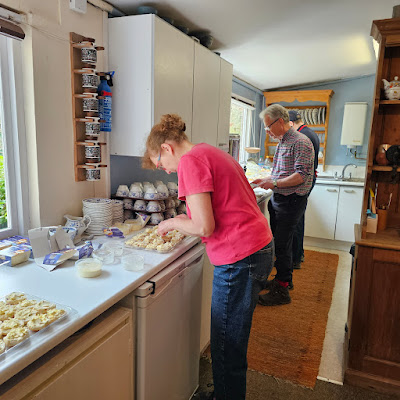At 10.30am the cream tea making and gazebo transport teams arrived. Gazebos were put up and secured by weights and 140 cream teas prepared. At 1pm stall holders arrived to set up a butterfly craft activity, Wirral Wildlife display, Samaritans plant sale and a beehive demonstration stall. At 1.30 pm the entrance and car parking teams arrived. Crowds gathered at the entrance over the ha-ha for the 2pm opening. The draw bridge was lowered over the ha-ha and visitors entered the enchanting world of the walled garden greeted by a friendly witch. There were musicians, roving archers and story tellers.
 |
| The Cream Tea Team. Photo: John Bateman |
The Walled Gardens, which include an Oriental, a Classical, a Nursery Rhyme and a Witch’s Garden, have interesting artworks inspired by the literary works of Roger Lancelyn Green, his friends and associates: Robin Hood and Excalibur from his Robin Hood and King Arthur retellings, an Ent from J.R.R, Tolkien’s Lord of the Rings, and a Jabberwock from Lewis Carroll’s Through the Looking Glass. The Parkland has a wildflower meadow surrounded by a nine-species laid hedge, each species with at least one tree allowed to grow. Mown paths enable walkers and runners to immerse themselves in it.
Dr Hilary Ash gave two tours of the wildflower grassland outside the ha-ha. The area was used for growing potatoes until 1993. Since then, it has been mown annually in late August or early September, with occasional aftermath grazing. The grassland’s fertility has gradually reduced and the grass sward height and density lowered. Grasses have become finer which has allowed space for marsh orchids to get in and for plants such as meadow buttercup, common sorrel, ribwort, and hairy tare to colonise the grassland. Yellow rattle could be rattled and seeds scattered and there were many meadow brown butterflies on the wing. This area is looking like a classic Cheshire meadow. The marsh orchids and their hybrids were particularly numerous this year. Much patience is required to make a wildflower meadow and this one has been 30 years in the making.
On the second tour Caroline Lancelyn Green, our hostess, joined the tour and expanded on how the hedgerow came about. Two of the far copses were occupied by badgers, one a sett and the other a latrine. The family loved badger watching and wanted to connect the copses up. Further to this there was an old painting in the hall looking over the copses which showed a previous hedge linking them together. In 1993 planting of the hedgerow started, a few sections at a time over the next few winters. Hedgerow shrubs were chosen for coloured flowers, fruits and winter coverage, with a total of nine species, one species for each century the family have lived here.
 |
| Tool sharpening at the Wirral Countryside Volunteers stall. Photo: John Bateman |
Wirral Countryside Volunteers held a mock ‘come and have a go’ hedge demonstration, tool sharpening, scything, and making a newspaper pot for taking cutting of plants such as rosemary. Three pots completed and then you could take them home in your very own plant incubator, a reused pipette tip holder box. One of the Wirral Countryside Volunteers, Jane, came and helped serve the cream teas and whist she was doing this had her billhook sharpened at the Wirral Countryside Volunteer stall. Jane was very pleased with this. Poulton Hall head gardener, Irene, got her billhook sharpened too and was equally delighted.
A new and interesting stall this year was Wirral Archaeology, a group of well informed and enthusiastic volunteers who research into the battle of Brunanburh in 937AD which is thought to have occurred nearby. This is when an alliance of Dublin Vikings, Scots and Britons came from the north of the peninsular and were defeated by Anglo-Saxon forces as they entered into the Anglo-Saxon part of Wirral. They had many interesting finds, all found within three miles of Poulton Hall, ancient coins, dice, a crotal bell that still worked after several centuries in the ground and Irish arrow heads from pre 950AD. They had excellent enlarged photographs of these artefacts so that you could really appreciate them and volunteers to explain their significance and bring them alive to you.
The day is a wonderful team effort requiring various roles, including being a witch at the entrance to the walled garden! Thank you to the 24 volunteers who made this event possible. This is the third time Wirral Wildlife have held this type of event and it is running along more smoothly each time it is hosted. Thanks also to Roger and Lynn for serving the cream teas, and Scirard, Caroline and Arthur Lancelyn Green and the hall staff for all their support to make it a successful day.


No comments:
Post a Comment